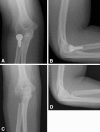Anconeus interposition arthroplasty: mid- to long-term results
- PMID: 24872196
- PMCID: PMC4048403
- DOI: 10.1007/s11999-014-3629-3
Anconeus interposition arthroplasty: mid- to long-term results
Abstract
Background: Radiocapitellar arthritis and/or proximal radioulnar impingement can be difficult to treat. Interposition of the anconeus muscle has been described in the past as an alternative option in managing arthritis, but there are little published data about relief of pain and restoration of function over the long term in patients treated with this approach.
Questions/purposes: We sought (1) to determine whether interposition of the anconeus muscle in the radiocapitellar and/or proximal radioulnar joint relieves pain and restores elbow function; and (2) to identify complications and reoperations after anconeus interposition arthroplasty.
Methods: Between 1992 and 2012, we surgically treated 39 patients having radiocapitellar arthritis and/or proximal radioulnar impingement with an anconeus interposition arthroplasty. These were performed for situations in which capitellar and/or radial head pathology was deemed not amenable to implant replacement. We had complete followup on 29 of them (74%) at a minimum of 1 year (mean, 10 years; range, 1-20 years). These 29 patients (21 males, eight females) had interposition of the anconeus muscle at the radiocapitellar joint (10 elbows), the proximal radioulnar joint (two elbows), or both (17 elbows). Their mean age at the time of surgery was 39 years (range, 14-58 years). The reasons for the previous determination or the indications included lateral-side elbow symptoms after radial head resection (eight elbows), failed internal fixation of radial head fracture (two elbows), failed radial head replacement with or without capitellar replacement (four elbows), osteoarthritis and Essex-Lopresti injury (six elbows), failed internal fixation of distal humeral fracture involving the capitellum (two elbows), posttraumatic osteoarthritis involving the lateral compartment (one elbow), lateral compartment osteoarthritis associated with chondropathies (three elbows), and primary osteoarthritis affecting the lateral compartment (three elbows). Patient-reported outcome tools included the quick-Disabilities of the Arm, Shoulder and Hand (quick-DASH) and the Mayo Elbow Performance Score (MEPS); we also performed a chart review for complications and reoperations.
Results: During the followup duration, the mean MEPS was significantly improved from (mean ± SD) 64 ± 17 points before surgery to 82 ± 14 points after surgery (p < 0.001) with 21 elbows (72%) graded as excellent or good at most recent followup. The mean quick-DASH score was 24 ± 17 points (n = 25) at latest evaluation. Two patients (7%) had perioperative complications, including wound dehiscence (one elbow) and transient posterior interosseous nerve palsy (one elbow). Seven patients (24%) underwent additional surgery.
Conclusions: Anconeus arthroplasty provides a reasonable surgical alternative in the armamentarium of procedures to address pathology at the radiocapitellar and/or proximal radioulnar joint. This procedure is especially attractive when other alternatives such as radial head replacement may be problematic secondary to capitellar erosion or marked proximal radius bone loss.
Level of evidence: Level IV, therapeutic study. See Guidelines for Authors for a complete description of levels of evidence.
Figures


Comment in
-
Letter to the editor: anconeus interposition arthroplasty: mid- to long-term results.Clin Orthop Relat Res. 2014 Nov;472(11):3581-2. doi: 10.1007/s11999-014-3856-7. Epub 2014 Aug 12. Clin Orthop Relat Res. 2014. PMID: 25113267 Free PMC article. No abstract available.
-
Reply to the letter to the editor: anconeus interposition arthroplasty: mid- to long-term results.Clin Orthop Relat Res. 2014 Nov;472(11):3583-4. doi: 10.1007/s11999-014-3857-6. Epub 2014 Sep 3. Clin Orthop Relat Res. 2014. PMID: 25183217 Free PMC article. No abstract available.
References
-
- Hudak PL, Amadio PC, Bombardier C. Development of an upper extremity outcome measure: the DASH (Disabilities of the Arm, Shoulder and Hand) [corrected]. The Upper Extremity Collaborative Group (UECG) Am J Ind Med. 1996;29:602–608. doi: 10.1002/(SICI)1097-0274(199606)29:6<602::AID-AJIM4>3.0.CO;2-L. - DOI - PubMed
-
- Morrey BF, An KN. Functional evaluation of the elbow. In: Morrey BF, Sanchez-Sotelo J, editors. The Elbow and Its Disorders. Philadelphia, PA USA: Elsevier Inc; 2009. pp. 80–91.
MeSH terms
LinkOut - more resources
Full Text Sources
Other Literature Sources
Medical
Research Materials
Miscellaneous

